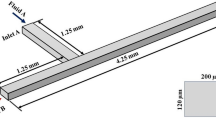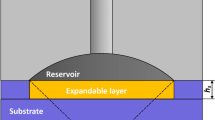Abstract
A microfluidic control device that uses an electroactive polymer for actuation has been recently proposed. This design has potential to control temperature sensitive particle-laden liquids. The electro-mechanical characteristics of ionic polymer metal composite (IPMC) actuators have been studied both theoretically and empirically. However, very little data has been published on the thermal behavior of IPMC actuators. To realize the proposed fluidic control device, it is essential to understand the thermal properties of the device under actuation conditions. This paper discusses the theoretical basis for developing a multiphysics model describing electroactive polymer actuation. In addition, experimental results are presented that give insight to the thermal characteristics of IPMC actuation.








Similar content being viewed by others
Abbreviations
- κ:
-
electrical permittivity
- E :
-
electric field
- σ:
-
surface charge density
- ϕ :
-
electrostatic potential
- C :
-
concentration
- F:
-
Faraday’s constant
- k h :
-
coefficient of hydraulic conductivity
- k e :
-
coefficient of electroosmotic permeability
- P :
-
pressure
- J w :
-
fluid flux per unit area
- J i :
-
mass flux of the ith ion
- D i :
-
diffusion constant of the ith ion
- u :
-
electrical ionic mobility
- z :
-
charge number of the ith ion
- ρ:
-
density
- c p :
-
specific heat capacity
- T :
-
temperature
- k :
-
thermal conductivity
- \( {\mathop q\limits^ \bullet } \) :
-
heat generation rate
- Ω:
-
fluid viscous dissipation
- \( {\mathop U\limits^ \to } \) :
-
pore fluid velocity vector
- μ:
-
fluid viscosity
- φ :
-
porosity
- ω:
-
capacity ratio
- H :
-
heat transfer coefficient
- A :
-
area
- α:
-
thermal diffusivity
- λ:
-
electrical conductivity
References
Berning T, Lu DM, Djilali N (2002) Three dimensional computational analysis of transport phenomena in a PEM fuel cell. J Power Sources 106:284–294
Hu M, Zhu X, Wang M, Gu A, Yu L (2004) Three dimensional, two phase flow mathematical model for PEM fuel cell: Part II. analysis and discussion of the internal transport mechanisms. Energy Convers Manage 45:1883–1916
Johnson T, Amirouche F (2008) Thermal behavior of ionic polymer actuation: empirical results. Int J Heat Technol (in press)
Kang Y, Yang C, Huang (2005) Joule heating induced transient temperature field and its effects on electroosmosis in a microcapillary packed with microspheres. Langmuir 21:7598
Lee S, Park Hoon C, Kim Kwang J (2005) Equivalent modeling for ionic polymer metal composite actuators based on beam theories. Smart Mater Struct 14(6):1363–1368
Nemat-Nasser S, Wu Y (2003) Comparative experimental study of ionic polymer-metal composites with different backbone ionomers and in various cation forms. J Appl Phys 93(9):5255–5267
Nguyen T, White R (1993) A water and heat management model for proton exchange membrane fuel cells. J Electrochem Soc 140:2178–2186
PDE Solutions Inc (2006) FlexPDE, version 5.0.11Sunol, CA
Segalman D, Witkowski W, Adolf D, Shahinpoor M (1992) Theory of electrically controlled polymeric muscles as active materials in adaptive structures. Int J Smart Mater Struct 1:44–54
Shahinpoor M, Kim Kwang J (2001) Ionic polymer-metal composites: fundamentals I. Smart Mater Struct 10:819–833
Shahinpoor M, Kim Kwang J (2004) Ionic polymer metal composites: III. modeling and simulation as biomimetic sensors, actuators, transducers, and artificial muscles. Smart Mater Struct 13(6):1362–1388
Shahinpoor M, Kim Kwang J (2005) Ionic polymer metal composites: IV. industrial and medical applications. Smart Mater Struct 14(1):197–214
Springer TE, Zawodzinski TA, Gottesfeld S (1991) Polymer electrolyte fuel cell model. J Electrochem Soc 138(8):2334–2342
Wang C-Y (2004) Fundamental models for fuel cell engineering. Chem Rev 104(10):4727–4766
Weber Adam Z, Newman J (2004) Modeling transport in polymer-electrolyte fuel cells. Chem Rev 104(10):4679–4726
Author information
Authors and Affiliations
Corresponding author
Rights and permissions
About this article
Cite this article
Johnson, T., Amirouche, F. Multiphysics modeling of an IPMC microfluidic control device. Microsyst Technol 14, 871–879 (2008). https://doi.org/10.1007/s00542-008-0603-6
Received:
Accepted:
Published:
Issue Date:
DOI: https://doi.org/10.1007/s00542-008-0603-6




